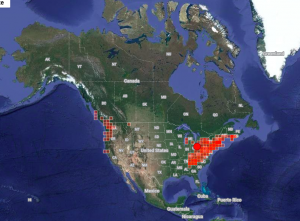| HWA in Nova Scotia Subpages – Eastern Hemlock Notes – About “In the Quiet & the Dark” – Comprehensive Info – The Adelgid (THIS PAGE) – Pesticide Treatment – Biological Control – Silviculture – Post HWA infestation Impacts |

Observations of HWA reported on iNaturalist (accessed Nov 15, 2023)
From Wikipedia (15Nov2023), references and some links removed:
“The hemlock woolly adelgid (Adelges tsugae), or HWA, is an insect of the order Hemiptera (true bugs) native to East Asia. It feeds by sucking sap from hemlock and spruce trees (Tsuga spp.; Picea spp.).
“In its native range, HWA is not a serious pest because populations are managed by natural predators and parasitoids and by host resistance.
“In eastern North America it is a destructive pest that threatens the eastern hemlock (Tsuga canadensis) and the Carolina hemlock (Tsuga caroliniana). HWA is also found in western North America, where it has likely been present for thousands of years. In western North America, it primarily attacks western hemlock Tsuga heterophylla and has only caused minor damage due to natural predators and host resistance.
“Accidentally introduced to North America from Japan, HWA was first found in the eastern United States near Richmond, Virginia, in 1951. The pest is now found from northern Georgia to coastal Maine and southwestern Nova Scotia.[As of 2015, 90% of the geographic range of eastern hemlock in North America has been affected by HWA.”
Read More on Wikipedia
Life Cycle

Life Cycle, click on image for larger version. From Maine Forest Service
Maine Forest Service: Hemlock Woolly Adelgid Life Stages
Webpage. “Hemlock woolly adelgids are all female in northeastern North America. They develop parthenogenetically (asexually) and have six stages of development: egg, four nymphal instars and adult. There are two overlapping generations per year. The overwintering generation (or sistens) is present from early summer through mid-spring, and the spring generation (or progrediens) is present from early spring through mid-summer.” The page goes on to describe, with photos added,
Eggs
Crawlers
Settled First Instar Nymphs
Instars 2 through 4 and Adults
Winged Adult (does not survive in North America)
